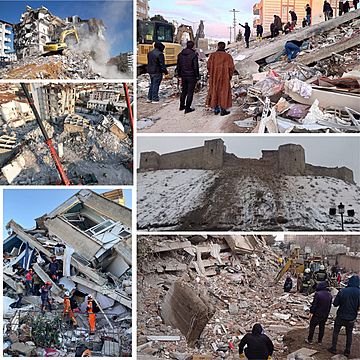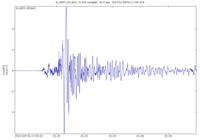2023 Turkey–Syria earthquake facts for kids

Clockwise from top left: Rescue efforts in Hama, Syria; Adıyaman; damaged Gaziantep Castle; Diyarbakır; Hatay; Hatay
|
|
| UTC time | 2023-02-06 01:17:35 |
|---|---|
| ISC event | 625613033 |
| USGS-ANSS | ComCat |
| Local date | 6 February 2023 |
| Local time | 04:17 TRT (UTC+3) |
| Duration | 80 seconds |
| Magnitude | Mww 7.8 |
| Depth | 10.0 km (6 mi) |
| Epicenter | Şehitkamil, Gaziantep 37°09′58″N 37°01′55″E / 37.166°N 37.032°E |
| Fault | Dead Sea Transform, East Anatolian Fault, Çardak–Sürgü Fault |
| Type | Strike-slip |
| Areas affected | Turkey and Syria |
| Total damage | US$84.1 billion (estimated) |
| Max. intensity | XI (Extreme) |
| Peak acceleration | 1.62 g |
| Tsunami | 17 cm (6.7 in) |
| Aftershocks | 2,109 (by 12 February) 340+ with a Mw 4.0 or greater Largest: Mw7.7 at 13:24 TRT (UTC+3), 6 February 2023 |
| Casualties | > 51,130 deaths, 122,500 injured
|
On 6 February 2023, at 04:17 TRT (01:17 UTC), a Mw 7.8 earthquake struck southern and central Turkey and northern and western Syria. The epicenter was 32 km (20 mi) west–northwest of Gaziantep. The earthquake had a maximum Mercalli intensity of XI (Extreme). It was followed by a Mw 7.7 earthquake at 13:24. This earthquake was centered 95 km (59 mi) to the north-northeast from the first, in Kahramanmaraş Province. There was widespread damage and tens of thousands of fatalities.
The Mw 7.8 earthquake was the strongest to occur in Turkey since the 1939 Erzincan earthquake of the same magnitude, and jointly the second-strongest recorded in the country, after the 1668 North Anatolia earthquake. It was also one of the strongest earthquakes ever recorded in the Levant. It was felt as far as Egypt, Israel, Palestine, Lebanon, Cyprus, and the Black Sea coast of Turkey. The earthquakes were followed by more than 2,100 aftershocks. The seismic sequence was the result of shallow strike-slip faulting.
There was widespread damage in an area of about 350,000 km2 (140,000 sq mi) (around twelve times the size of Belgium). An estimated 14 million people, or 16 percent of Turkey's population, were affected. Development experts from the United Nations estimated that about 1.5 million people were left homeless.
As of 26 February 2023[update] more than 51,100 deaths were confirmed: more than 44,300 in Turkey, and more than 6,700 in Syria. It is the deadliest earthquake in Turkey since the 526 Antioch earthquake and the deadliest in Syria since the 1822 Aleppo earthquake. It was the deadliest worldwide since the 2010 Haiti earthquake, and the fifth-deadliest of the 21st century. Collectively, the earthquakes are estimated to have caused US$84.1 billion in damages, making them the fourth-costliest earthquakes on record. It is the deadliest natural disaster in Turkey's modern history.
Damaged roads, winter storms, and disruption to communications have hampered the national disaster agency AFAD's rescue and relief effort, which included a 60,000-strong search-and-rescue force, 5,000 health workers and 30,000 volunteers. Following Turkey's call for international help, more than 141,000 people from 94 countries joined the rescue effort.
Contents
Earthquakes
Mainshock
The earthquake struck at at 01:17 UTC. It had an epicenter 34 km (21 mi) west of Gaziantep in Gaziantep Province, which is near the border with Syria. It is the strongest ever recorded in Turkey, equaling the 1939 Erzincan earthquake, and globally the largest earthquake ever recorded since August 2021.
Estimation of losses
According to a professor of geophysics at the Kandilli Observatory, the death toll could be similar to the 1999 İzmit earthquake, in which 18,373 people died. On 6 February, when the death toll was over 3,400, the World Health Organisation warned that it could be 8 times higher.
Following the earthquakes, the Turkish lira value struck a record low of 18.85 against the US dollar. Turkish stock markets fell; main equities benchmark fell as much as 5 percent and banks fell 5.5 percent but recovered from the losses. The country's main stock market dropped 1.35 on 6 February.
Tsunami alert
Small tsunami waves were recorded off the coast of Famagusta, Cyprus, without damage, according to the Geological Survey Department.
The Civil Protection Department of Italy issued an alert, which was later withdrawn, reporting the risk of possible tsunami waves striking the coasts of Sicily, Calabria and Apulia. Coastal residents in the aforementioned regions were advised to flee to higher ground and follow local authorities, while state-owned train operator Trenitalia temporarily suspended rail services in the areas, which were later resumed the same morning.
Aftermath
Early reports from Turkish authorities said more than 5,600 buildings were destroyed, including a state hospital in the city of Iskenderun. Several tens of thousands of people across Turkey and Syria were left homeless and spent the night in cold weather. Mosques in Turkey were used as shelters for people unable to return to their homes amid freezing temperatures. In Gaziantep, people sought refuge in shopping malls, stadiums, community centers, and mosques.
Images for kids
-
Wreckage of the collapsed Galeria Business Center, Diyarbakır
See also
 In Spanish: Terremotos de Turquía y Siria de 2023 para niños
In Spanish: Terremotos de Turquía y Siria de 2023 para niños























